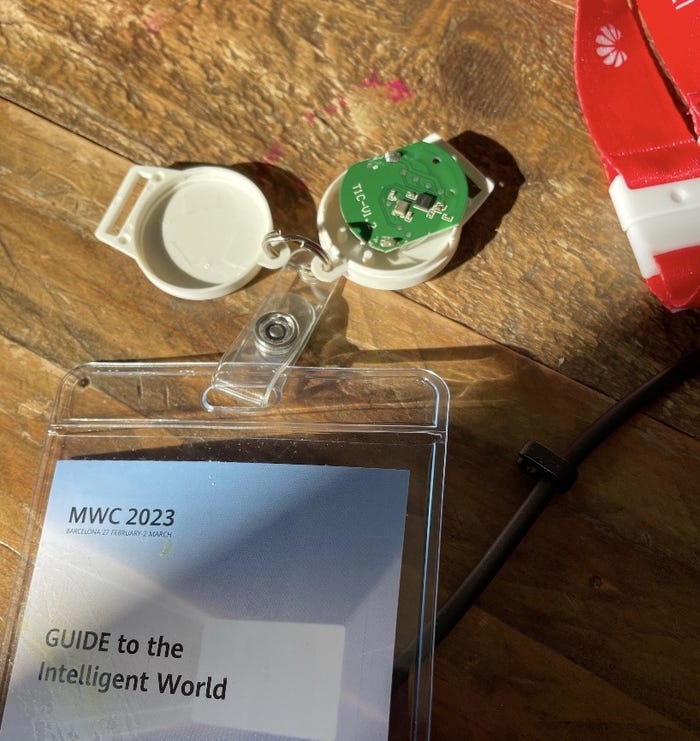The mysterious case of the chips inside Huawei's lanyards could be an embarrassment for MWC organizers.

MWC23 – Visitors to Huawei's monster booth at this year's Mobile World Congress (MWC) are supposed to return their badges and lanyards when they leave. But at least a few leaked through Huawei's security perimeter onto other parts of the show floor. Attached to each lanyard is a small plastic container. It is presumably not meant to be taken apart, but several visitors who did that found themselves staring at what looks like a tiny electronic chip – the sort that might be used for tracking movement.
Rolf Werner, who recently joined Huawei rival Nokia as senior vice president of Europe, showed off one of the circuits during an interview with Light Reading and said they could be used as trackers. One possibility is that Huawei is using Beacon technology at its booth. Beacon relies on low-power signals for tracking over distances of up to 70 meters.

The plastic container attached to the lanyard includes what looks like circuitry.
(Source: Light Reading)
The back of the Huawei badge does refer to the use of local-area radio systems that could aid tracking. It reads: "We use RFID and Bluetooth technology to collect the swipe time of this Huawei Card at the entrance of Huawei exhibition area, real-time location information and the residence time information of this Huawei Card holders within Huawei exhibition area, such information will be collected and processed only for the purpose of analyzing the overall interests of our invitees in our products to enhance our service quality. We will protect such information according to our Privacy Policy."
Light Reading sought comment from Huawei and at the time of publication had been told by a spokesperson that "the Huawei pass is used only in the booth and returned when visitors get out." The spokesperson went on to say: "There is no need to track location."
Unhappiness and surprise
Several visitors are known to be unhappy about the discovery. The garbled explanation about RFID and Bluetooth on the reverse of a badge few wearers are likely to examine does not smack of transparency. Others are surprised at what they see as Huawei's incautiousness. The company has regularly been accused of installing "backdoors" in its products to spy on people in European countries, allegations Huawei denies. It was on national security grounds that US authorities imposed sanctions against Huawei, prompting governments such as the UK's to restrict or ban it in 5G.
On Twitter, one show visitor linked to a video image of a plastic container being taken apart at what is apparently Nokia's booth. While the source of the image could not be verified, it looks identical to the plastic containers seen by Light Reading. The accompanying text reads: "Opening the lanyard of one of our competitors in #MWC23 #MWC2023. OK – maybe it is just tracking which demos a visitor sees at our competitor's booth. Some of the people who found out did not like it at all. Some people forgot theirs in @Nokia booth."
The tweeter included a link to an explanation of European Union rules under the General Data Protection Regulation, noting that "individuals have the right to know what information is being collected about them, the purpose of the collection, and how it will be used."
amazing 🤔😂 well done all the operators who use this "Orange" Company from China called #Huawei #MWC2023 #MWC23 #MWCBarcelona2023 pic.twitter.com/D3hYAGpMzl
— ruuki (@Officialruuki) March 2, 2023
The discovery of circuitry in Huawei lanyards is also potentially embarrassing for the GSM Association (GSMA), the lobby group that organizes MWC each year. The GSMA derives most of its annual revenues from MWC and spinoff shows, and Huawei is one of the big three exhibition sponsors (the others being Ericsson and Nokia). This year's event in Barcelona attracted more than 88,500 attendees, the GSMA has claimed. That would make MWC23 the biggest show since 2019.
Light Reading approached the GSMA for comment and received the following comment by email: "Of course you will be aware that some vendors do require booth visitors to remove competitor lanyards and branding for obvious reasons but the suggestion of tracking devices is a serious allegation. We are investigating that but don't have details to share at this moment."
Huawei was out in force at this year's MWC, showing off equipment and parading an army of executives. But it has been locked out of several Western markets on security grounds, and it remains subject to US sanctions cutting it off from vital componentry. Earlier this week, Tommi Uitto, the head of Nokia's mobile business group, said "high-risk vendors" unable to access the latest silicon designs were "going backward."
Update: The story has been amended to indicate that Huawei has always denied the allegations about spying and to note that government bans such as the UK's came after the US imposed sanctions against Huawei.
Related posts:
— Iain Morris, International Editor, Light Reading
About the Author(s)
You May Also Like











